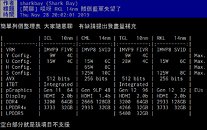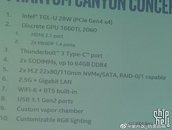
Intel's Next-Generation Tiger Lake-U Core i7-1165G7 CPU Score Leaks
Intel is preparing to launch its next-generation Tiger Lake-U lineup of CPUs based on the new Willow Cove core that is supposed to bring big IPC gains and plenty of new features. Being a part of the 11th generation of Core CPUs, these processors are expected to arrive sometime in the second half of 2020, built on Intel's 10 nm+ manufacturing process. Thanks to a popular hardware leaker @_rogame, we have found another Tiger Lake-U in the 3D Mark benchmark database. Unlike the last time when we saw Intel's Core i7-1185G7 being run on the 3D Mark tests, we now have test results of its brother - the Core i7-1165G7.
From the 3D Mark report, we can see some details like CPU's base frequency, which is 2.8 GHz in this case. This is just 200 MHz lower compared to the previous Core i7-1185G7 CPU that leaked. The platform used to test the new Core i7-1165G7 CPU was running Windows 10 and had 16 GB of DDR4 SODIMM memory. The new 3D Mark results are already looking promising. From the previous leak of Core i7-1185G7, we saw that Tiger Lake CPU which managed to score 2922 in the CPU test, 1296 in GPU test, and an overall score of 1414. However, this new Core i7-1165G7 CPU is a bit different. In the graphic test, it scores 1150 points, while the CPU test shows an impressive 4750 points. This Core i7-1165G7 result is much higher compared to the more powerful Core i7-1185G7 CPU, which is a bit strange. It could be attributed to a faster memory, but so far we don't know. However, the overall score of the i7-1165G7 is a bit lower compared to i7 1185G7, scoring 1297 points.
From the 3D Mark report, we can see some details like CPU's base frequency, which is 2.8 GHz in this case. This is just 200 MHz lower compared to the previous Core i7-1185G7 CPU that leaked. The platform used to test the new Core i7-1165G7 CPU was running Windows 10 and had 16 GB of DDR4 SODIMM memory. The new 3D Mark results are already looking promising. From the previous leak of Core i7-1185G7, we saw that Tiger Lake CPU which managed to score 2922 in the CPU test, 1296 in GPU test, and an overall score of 1414. However, this new Core i7-1165G7 CPU is a bit different. In the graphic test, it scores 1150 points, while the CPU test shows an impressive 4750 points. This Core i7-1165G7 result is much higher compared to the more powerful Core i7-1185G7 CPU, which is a bit strange. It could be attributed to a faster memory, but so far we don't know. However, the overall score of the i7-1165G7 is a bit lower compared to i7 1185G7, scoring 1297 points.






























